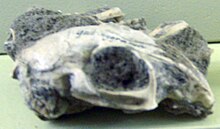You can help expand this article with text translated from the corresponding article in Polish. (September 2020)Click [show] for important translation instructions.
|
| Serengetilagus [1] Temporal range: | |
|---|---|
 | |
| Serengetilagus praecapensis skull, Naturkunde Museum, Berlin. | |
| Scientific classification | |
| Domain: | Eukaryota |
| Kingdom: | Animalia |
| Phylum: | Chordata |
| Class: | Mammalia |
| Order: | Lagomorpha |
| Family: | Leporidae |
| Genus: | † Serengetilagus Dietrich 1942 |
| Species | |
| |
Serengetilagus is an extinct genus of lagomorph in the family Leporidae. It lived in the Pliocene of Kenya and Tanzania and the Late Miocene of Chad. [2] Serengetilagus is the best-represented taxon from Laetoli, with approximately 34 percent of fossils in the Laetolil Beds attributed to this genus. Additional specimens from Angola, Morocco [3] and Ukraine [4] may also belong to this genus. It had a number of specific features unknown in other lagomorphs, such as a "missing" mesoflexid on its third premolar. [5]
The genus is represented by two species: Serengetilagus praecapensis , the type species, and S. tchadensis , known from 18 specimens from the Toros Menalla locality of Chad. [6]

